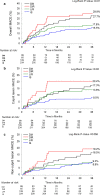Relationship between insulin resistance, coronary plaque, and clinical outcomes in patients with acute coronary syndromes: an analysis from the PROSPECT study
- PMID: 33413366
- PMCID: PMC7791845
- DOI: 10.1186/s12933-020-01207-0
Relationship between insulin resistance, coronary plaque, and clinical outcomes in patients with acute coronary syndromes: an analysis from the PROSPECT study
Abstract
Background: We investigated the association of insulin resistance (IR) with coronary plaque morphology and the risk of cardiovascular events in patients enrolled in the Providing Regional Observations to Study Predictors of Events in Coronary Tree (PROSPECT) study.
Methods: Patients with acute coronary syndromes (ACS) were divided based on DM status. Non-DM patients were further stratified according to homeostasis-model-assessment IR (HOMA-IR) index as insulin sensitive (IS; HOMA-IR ≤ 2), likely-IR (LIR; 2 < HOMA-IR < 5), or diabetic-IR (DIR; HOMA-IR ≥ 5). Coronary plaque characteristics were investigated by intravascular ultrasound. The primary endpoint was major adverse cardiac events (MACE); a composite of cardiac death, cardiac arrest, myocardial infarction, and rehospitalization for unstable/progressive angina.
Results: Among non-diabetic patients, 109 patients (21.5%) were categorized as LIR, and 65 patients (12.8%) as DIR. Patients with DIR or DM had significantly higher rates of echolucent plaque compared with LIR and IS. In addition, DIR and DM were independently associated with increased risk of MACE compared with IS (adjusted hazard ratio [aHR] 2.29, 95% confidence interval [CI] 1.22-4.29, p = 0.01 and aHR 2.12, 95% CI 1.19-3.75, p = 0.009, respectively).
Conclusions: IR is common among patients with ACS. DM and advanced but not early stages of IR are independently associated with increased risk of adverse cardiovascular events. Trial Registration ClinicalTrials.gov Identifier: NCT00180466.
Keywords: Acute coronary syndrome; Culprit and non-culprit lesion events; Glucose; Insulin; Insulin resistance.
Conflict of interest statement
Akiko Maehara: Grant support from Abbott Vascular and Boston Scientific, consultant for Conavi Medical Inc. Bernard De Bruyne: Institutional grant support from Abbott, Boston Scientific, and Biotronik AG; institutional consulting fees from Abbott, Opsens, and Boston Scientific. Roxana Mehran: Institutional Grant Support (funding to the institution)—AstraZeneca, Bayer, Beth Israel Deaconess, BMS, CSL Behring, DSI, BSC, Novartis Pharmaceuticals, OrbusNeich; Consulting Fees—Medscape, Regeneron Pharmaceuticals (no fee, Sanofi, Abbott Laboratories (personal fees for speaking engagements; consultant (paid to the institution), Abiomed and The Medicines Company (consultant – spouse); Scientific Advisory Board/Advisory Board—PLx Opco Inc./PLx Pharma Inc. (scientific advisory board), Bristol Myers Squibb (advisory board; funding to the institution); Equity < 1%—Claret Medical, Elixir Medical; Executive Committee (paid to the institution)—Janssen Pharmaceuticals; DSMB Membership—Watermark Research Partners. Patrick W. Serruys: Consultant – Abbott, Biosensors, Medtronic, Micell Technologies, SINOMED, Philips/Volcano, Xeltis, HeartFlow. Gary S. Mintz: Honoraria—Boston Scientific, Philips, Terumo, and Medtronic. The rest of the authors: none.
Figures


Similar articles
-
Impact of Pre-Diabetes on Coronary Plaque Composition and Clinical Outcome in Patients With Acute Coronary Syndromes: An Analysis From the PROSPECT Study.JACC Cardiovasc Imaging. 2019 Apr;12(4):733-741. doi: 10.1016/j.jcmg.2017.06.023. Epub 2017 Oct 18. JACC Cardiovasc Imaging. 2019. PMID: 29055637
-
Plaque composition and clinical outcomes in acute coronary syndrome patients with metabolic syndrome or diabetes.JACC Cardiovasc Imaging. 2012 Mar;5(3 Suppl):S42-52. doi: 10.1016/j.jcmg.2012.01.008. JACC Cardiovasc Imaging. 2012. PMID: 22421230
-
Relationship between palpography and virtual histology in patients with acute coronary syndromes.JACC Cardiovasc Imaging. 2012 Mar;5(3 Suppl):S19-27. doi: 10.1016/j.jcmg.2011.02.026. JACC Cardiovasc Imaging. 2012. PMID: 22421227
-
Coronary plaque composition, morphology, and outcomes in patients with and without chronic kidney disease presenting with acute coronary syndromes.JACC Cardiovasc Imaging. 2012 Mar;5(3 Suppl):S53-61. doi: 10.1016/j.jcmg.2011.12.008. JACC Cardiovasc Imaging. 2012. PMID: 22421231
-
Redefining residual inflammatory risk after acute coronary syndrome.Future Cardiol. 2022 Feb;18(2):115-123. doi: 10.2217/fca-2021-0032. Epub 2021 Aug 16. Future Cardiol. 2022. PMID: 34397269 Review.
Cited by
-
Triglyceride-glucose index as a predictor of cardiac adverse events in acute coronary syndrome patients undergoing percutaneous coronary intervention: role of diabetes.BMC Cardiovasc Disord. 2024 Sep 27;24(1):514. doi: 10.1186/s12872-024-04191-5. BMC Cardiovasc Disord. 2024. PMID: 39333881 Free PMC article.
-
The relative and combined ability of triglyceride-glucose index and stress hyperglycemia ratio to predict major adverse cardio-cerebral events in patients with multivessel coronary artery disease.Diabetol Metab Syndr. 2024 Sep 28;16(1):234. doi: 10.1186/s13098-024-01471-0. Diabetol Metab Syndr. 2024. PMID: 39342410 Free PMC article.
-
Using XGBoost for Predicting In-Stent Restenosis Post-DES Implantation: Role of Lymphocyte-to-Monocyte Ratio and Residual Cholesterol.Int J Gen Med. 2024 Aug 9;17:3443-3452. doi: 10.2147/IJGM.S477053. eCollection 2024. Int J Gen Med. 2024. PMID: 39139709 Free PMC article.
-
The metabolic score for insulin resistance in the prediction of major adverse cardiovascular events in patients after coronary artery bypass surgery: a multicenter retrospective cohort study.Diabetol Metab Syndr. 2023 Jul 17;15(1):157. doi: 10.1186/s13098-023-01133-7. Diabetol Metab Syndr. 2023. PMID: 37461067 Free PMC article.
-
Triglyceride-glucose index level and variability and outcomes in patients with acute coronary syndrome undergoing percutaneous coronary intervention: an observational cohort study.Lipids Health Dis. 2022 Dec 8;21(1):134. doi: 10.1186/s12944-022-01731-w. Lipids Health Dis. 2022. PMID: 36482415 Free PMC article.
References
Publication types
MeSH terms
Associated data
LinkOut - more resources
Full Text Sources
Other Literature Sources
Medical

